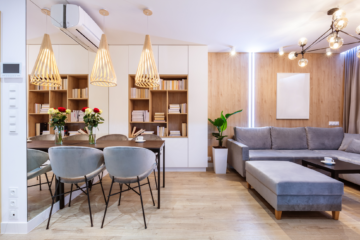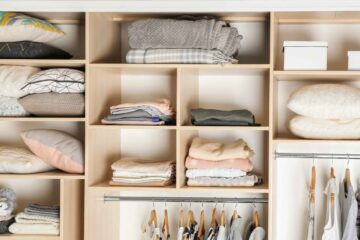Are your kitchen cabinets overflowing? Don’t let the mess stress you out. We’re here to help you learn how to organize kitchen cabinets and create a functional space. Transform your chaotic cabinet corners into a model of organization with our easy-to-follow strategies. Unleash the true potential of your kitchen space.
Start with a Clean Slate
With everything out of your cabinets, you can thoroughly clean all surfaces. Wipe down shelves, drawers, and the insides of the cabinet doors. This removes any dust, spills, or crumbs that have accumulated. Now that your cabinets are empty and clean, it’s time to declutter.
Get Rid of Unnecessary Items
Sort through all the items you removed from your cabinets. Be honest with yourself about what you need and use. Throw away anything expired, broken, or damaged. This includes expired spices, chipped mugs, and mismatched food storage containers.
Donate and Repurpose
If you have items in good condition that you no longer use, consider donating them. This helps others and declutters your kitchen. You might also find creative ways to repurpose some items. For example, old mason jars can become storage containers for pantry staples.
Simplify Your Collection
Many of us have more kitchen items than we need. Take a look at your dishes, glasses, and utensils. Do you really need five sets of wine glasses or multiple spatulas? Keep only what you use regularly and let go of the excess.
Make Tough Choices
Decluttering can be hard, especially with sentimental items. If you have kitchenware you don’t use but holds sentimental value, consider displaying it elsewhere or taking a photo to preserve the memory. Remember, the goal is a functional kitchen.
How to Organize Kitchen Cabinets
Now that your cabinets are decluttered, you’re ready to create a layout that works for you. A good layout makes your kitchen more efficient and enjoyable to use. Here are some ideas:
Prioritize Everyday Items
Keep frequently used items within easy reach. Store your everyday dishes, glasses, and utensils in cabinets near the dishwasher or sink. Place your go-to cookware close to the stove. Keep your most-used spices and oils near your prep area.
Utilize Vertical Space
Don’t waste the vertical space in your cabinets. Install shelves or use stackable organizers to create more storage. Store lesser-used items or appliances on higher shelves. Consider a small step stool for easy access.
Create Functional Zones
Divide your cabinets into zones based on function. Group similar items together. For example, create a baking zone, a breakfast zone, and a school lunch zone. This helps you find what you need quickly and allows the whole family to function well in the space. You could even designate a lower cabinet or drawer for the kids’ snacks and dishes. This gives them independence and keeps the rest of your kitchen organized.
Be Flexible
Your kitchen layout should be flexible. As your cooking habits or family dynamics change, rearrange your cabinets to suit your needs.
Organize Kitchen Cabinets with the Right Tools
After planning your layout, it’s time to use organizers. Organizers make your cabinets more functional and help you keep things tidy while maximizing the space you have to use.
Think about the size and shape of your items, and how deep and tall your cabinets are. Here are some kitchen organizers to get you started:
Turntables for Corners
Corner cabinets can be tricky. A turntable (AKA lazy susan) makes it easy to reach items stored in the back. Use it for oils, vinegar, or spices.
Pan and Lid Organizers
Pots and pans can easily get messy. Pan and lid organizers help you stack your cookware neatly, preventing scratches and saving space.
Small Bins for Small Items
Small bins are great for organizing spice packets, sauce packets, or tea bags. They keep these small items from getting lost in your cabinets but are also great to divide drawers.
Pull-Out Shelves/Drawers for Easy Access
Pull-out shelves or drawers are helpful for deep cabinets. They make it easy to reach items at the back without taking everything out. Use them for pots, pans, or appliances.
Expandable Spice Racks and Shelf Risers
Expandable spice racks and shelf risers create more storage space. Use them for spices and canned goods. They also make it easier to see what you have.
When buying organizers, choose sturdy ones that can hold the weight of your kitchen items. A good organizer is a worthwhile investment for your kitchen.
Label Your Belongings
Labels help you remember where you put things, even if you haven’t used them in a while. They also help others in your household find what they need.
Use labels for frequently used items, especially those in opaque containers or deep drawers. You can use chalkboard labels, adhesive labels, or even create your own. Get creative and make your labels fun and personal.
Decant Your Pantry Staples
Decanting means moving your pantry staples like flour, sugar, and spices into clear containers. It takes a bit of work upfront, but it makes your pantry look great and function better.
Clear containers create a clean and organized look. You can easily see how much you have left of each ingredient, which helps you avoid buying too much or letting things expire. Plus, it’s easy to find what you need when everything is visible.
Remember to label each container with the ingredient and expiration date. This keeps your pantry organized and your food fresh.
Keep Your Kitchen Cabinets Tidy
Now, that you know how to organize kitchen cabinets into a simplified and efficient space, dedicate a few minutes each week to maintain them. Clutter can build up quickly, so you’ll need to regularly tidy up.
If you need professional help organizing your kitchen or any other space in your home, reach out to our team at Pretty Neat. We create clutter-free and functional environments in Oklahoma City, Edmond, and Norman.
Intimidated by clutter and chaos but not sure if you need a professional organizers? Sign up for our newsletter of tips and tricks and how to get started.
See You Soon,
Audra


